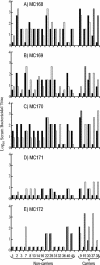Development of immunity to serogroup B meningococci during carriage of Neisseria meningitidis in a cohort of university students
- PMID: 15501781
- PMCID: PMC523012
- DOI: 10.1128/IAI.72.11.6503-6510.2004
Development of immunity to serogroup B meningococci during carriage of Neisseria meningitidis in a cohort of university students
Abstract
Understanding the basis of protective immunity is a key requirement for the development of an effective vaccine against infection with Neisseria meningitidis of serogroup B. We have conducted a longitudinal study into the dynamics of meningococcal acquisition and carriage in first-year university students. The detection of carriage of serogroup B meningococci correlated with an increase in detection of serum bactericidal activity (SBA) against both colonizing and heterologous serogroup B strains. Once induced, SBA remained high throughout the study. Although students showed increases in antibodies reactive with capsular polysaccharide and lipopolysaccharide (LPS), these antibody responses were transitory, and their decline was not accompanied by a corresponding decline in SBA. In contrast, there was a significant correlation between the presence of antibodies to the PorA outer membrane protein and SBA against both homologous and heterologous strains. SBA induced by a PorA-negative mutant confirmed the contribution of PorA to heterologous activity. Increases in SBA against a range of serogroup B strains were also observed in students in whom no meningococcal carriage was detected. This heterologous protection could not be associated with the presence of antibodies reacting with capsule, LPS, PorA, PorB, Rmp, Opa, Opc, or pilin, demonstrating that other, as yet unidentified, antigens contribute to the development of immunity to serogroup B meningococci. Identification of such antigens with the ability to induce an effective cross-reactive bactericidal response to a range of strains would be a major step in the production of a universally effective vaccine against infections caused by serogroup B meningococci.
Figures




Similar articles
-
Serological correlates of protection against meningococci in a cohort of university students, before and during an outbreak of serogroup C infection.J Infect Dis. 2003 May 1;187(9):1433-41. doi: 10.1086/374648. Epub 2003 Apr 15. J Infect Dis. 2003. PMID: 12717625
-
Comparison of phenotypically indistinguishable but geographically distinct Neisseria meningitidis Group B isolates in a serum bactericidal antibody assay.Clin Vaccine Immunol. 2007 Nov;14(11):1451-7. doi: 10.1128/CVI.00195-07. Epub 2007 Sep 19. Clin Vaccine Immunol. 2007. PMID: 17881507 Free PMC article.
-
Seroprevalence of bactericidal and anti-outer membrane vesicle antibodies to Neisseria meningitidis group B in England.Clin Vaccine Immunol. 2007 Jul;14(7):863-8. doi: 10.1128/CVI.00102-07. Epub 2007 May 9. Clin Vaccine Immunol. 2007. PMID: 17494636 Free PMC article.
-
Meningococcal surrogates of protection--serum bactericidal antibody activity.Vaccine. 2005 Mar 18;23(17-18):2222-7. doi: 10.1016/j.vaccine.2005.01.051. Vaccine. 2005. PMID: 15755600 Review.
-
A combination recombinant protein and outer membrane vesicle vaccine against serogroup B meningococcal disease.Expert Rev Vaccines. 2011 May;10(5):575-88. doi: 10.1586/erv.11.32. Expert Rev Vaccines. 2011. PMID: 21604979 Review.
Cited by
-
Sex-Related Differences in the Immune Response to Meningococcal Vaccinations During Adolescence.Front Public Health. 2022 May 6;10:871670. doi: 10.3389/fpubh.2022.871670. eCollection 2022. Front Public Health. 2022. PMID: 35602158 Free PMC article.
-
Evolution of meningococcal carriage in serogroups X and Y before introduction of MenAfriVac in the health district of Kaya, Burkina Faso.BMC Infect Dis. 2014 Oct 14;14:546. doi: 10.1186/s12879-014-0546-8. BMC Infect Dis. 2014. PMID: 25311771 Free PMC article.
-
Phase variation of PorA, a major outer membrane protein, mediates escape of bactericidal antibodies by Neisseria meningitidis.Infect Immun. 2013 Apr;81(4):1374-80. doi: 10.1128/IAI.01358-12. Epub 2013 Feb 12. Infect Immun. 2013. PMID: 23403557 Free PMC article.
-
Persistence, replacement, and rapid clonal expansion of meningococcal carriage isolates in a 2008 university student cohort.J Clin Microbiol. 2011 Feb;49(2):506-12. doi: 10.1128/JCM.01322-10. Epub 2010 Dec 1. J Clin Microbiol. 2011. PMID: 21123536 Free PMC article.
-
Neisseria meningitidis escape from the bactericidal activity of a monoclonal antibody is mediated by phase variation of lgtG and enhanced by a mutator phenotype.Infect Immun. 2008 Nov;76(11):5038-48. doi: 10.1128/IAI.00395-08. Epub 2008 Aug 11. Infect Immun. 2008. PMID: 18694967 Free PMC article.
References
-
- Balmer, P., R. Borrow, and E. Miller. 2002. Impact of meningococcal C conjugate vaccine in the UK. J. Med. Microbiol. 51:717-722. - PubMed
-
- Brooks, J. L., R. J. Fallon, and J. E. Heckels. 1995. Sequence variation in class 1 outer membrane protein in Neisseria meningitidis isolated from patients with meningococcal infection and close household contacts. FEMS Microbiol. Lett. 128:145-150. - PubMed
-
- Cartwright, K. A. V. 1995. Meningococcal carriage and disease, p. 115-146. In K. A. V. Cartwright (ed.) Meningococcal disease. John Wiley & Sons, Chichester, United Kingdom.
-
- Corless, C. E., M. Guiver, R. Borrow, V. Edwards-Jones, A. J. Fox, and E. B. Kaczmarski. 2001. Simultaneous detection of Neisseria meningitidis, Haemophilus influenzae, and Streptococcus pneumoniae in suspected cases of meningitis and septicemia using real-time PCR. J. Clin. Microbiol. 39:1553-1558. - PMC - PubMed
Publication types
MeSH terms
Substances
LinkOut - more resources
Full Text Sources
Other Literature Sources
Medical

